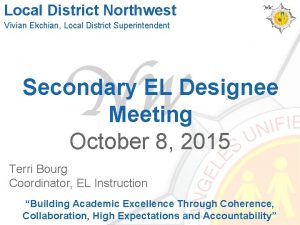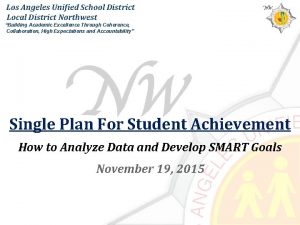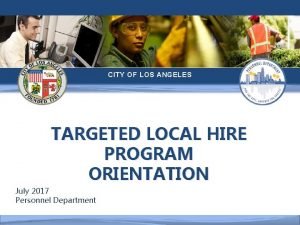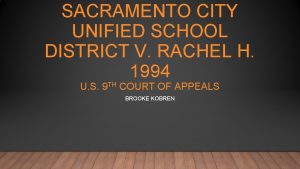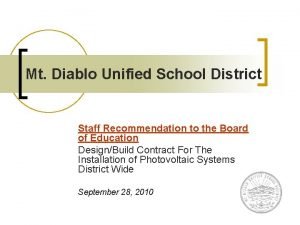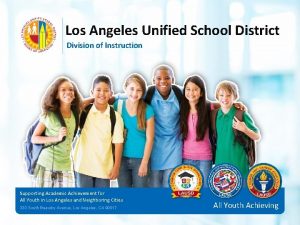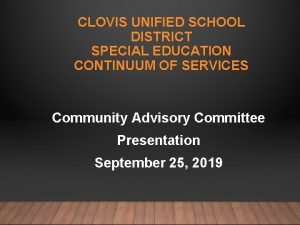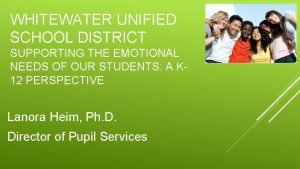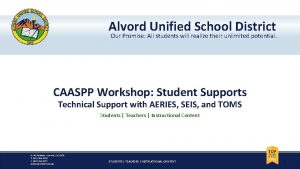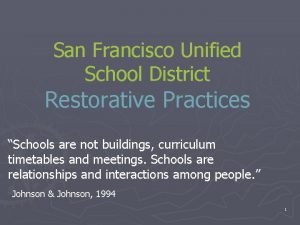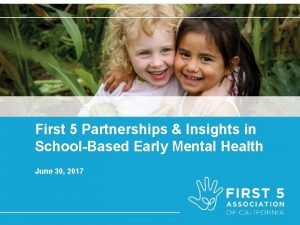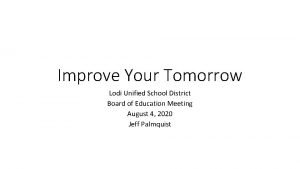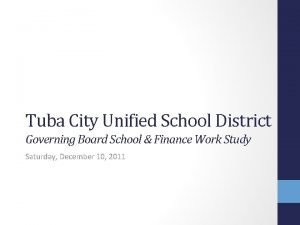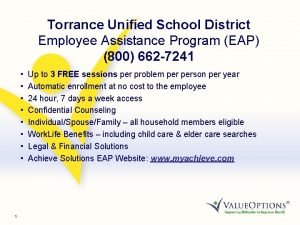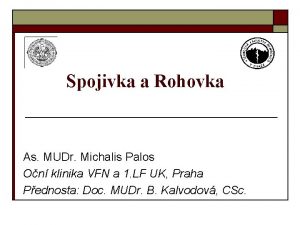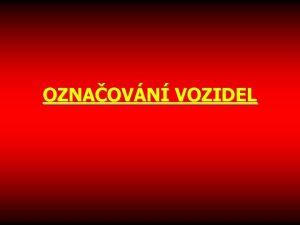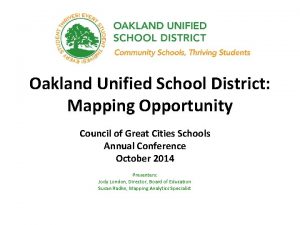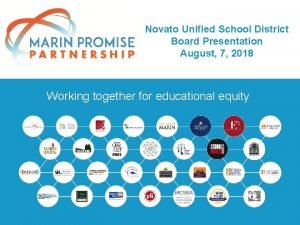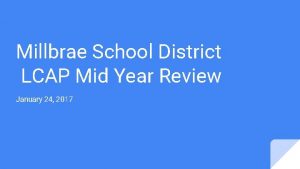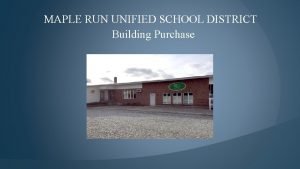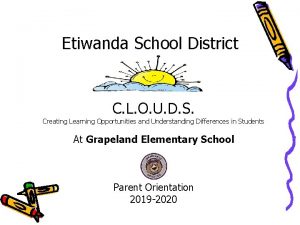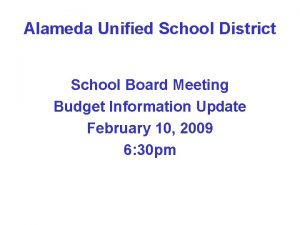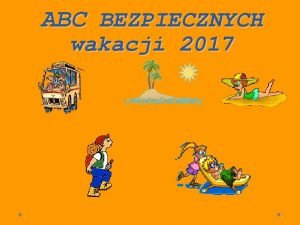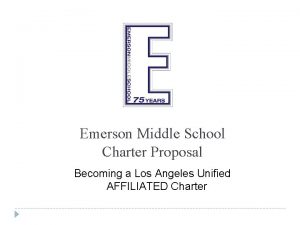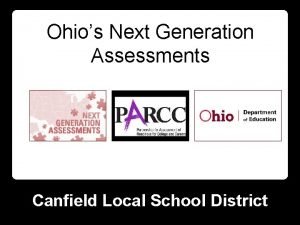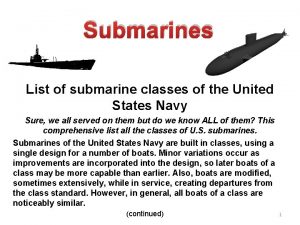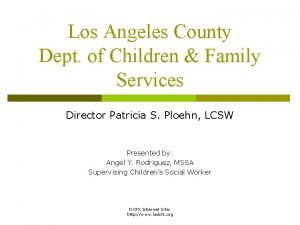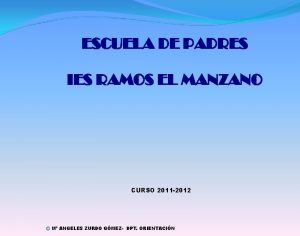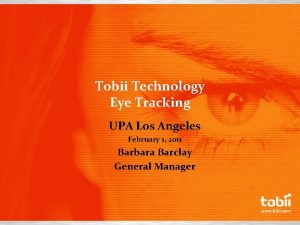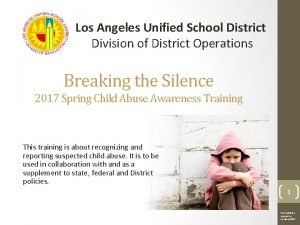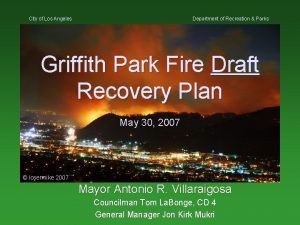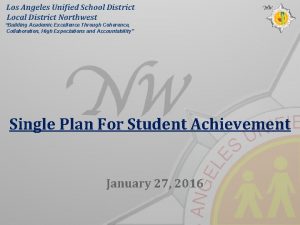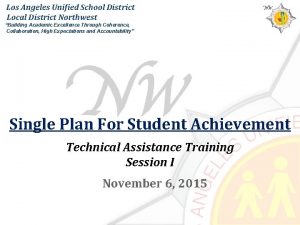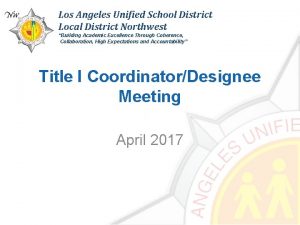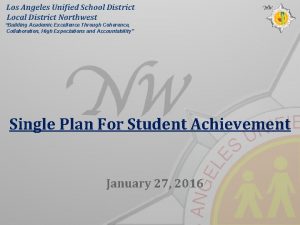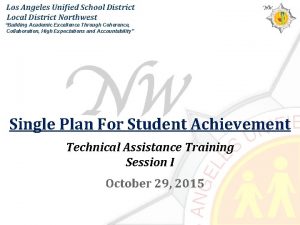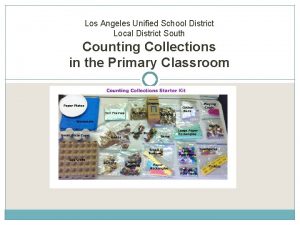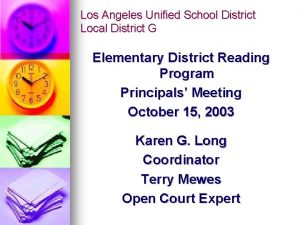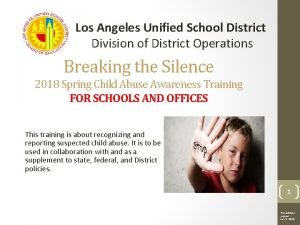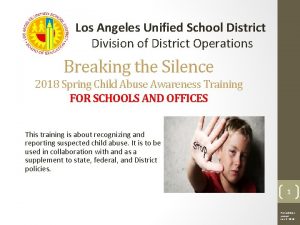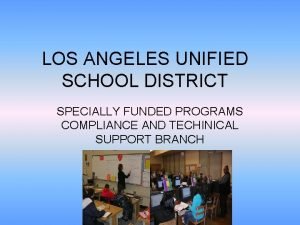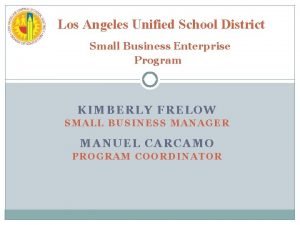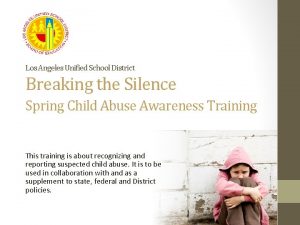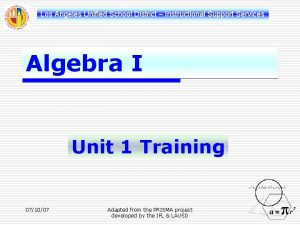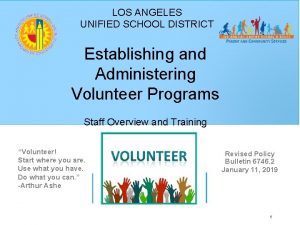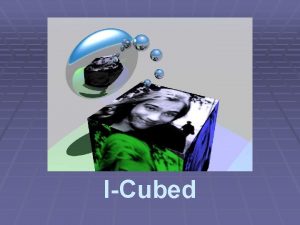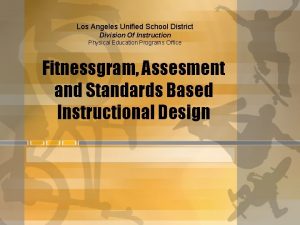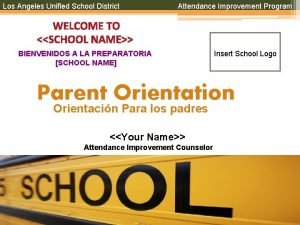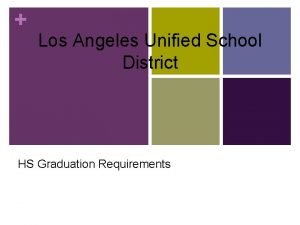Los Angeles Unified School District Local District Northwest



















































- Slides: 51

Los Angeles Unified School District Local District Northwest “Building Academic Excellence Through Coherence, Collaboration, High Expectations and Accountability” Communities of Practice 2016 -17 September 8, 2016 northwest. lausd. net Local. District. Northwest 1 lausdnorthwest

Inclusion Activity Synectics • Joining unrelated elements • The association of facts and ideas into new configurations of interpretation and understanding • Two basic processes • Making the Strange Familiar • Making the Familiar Strange

My job as a(n) __ is like a __ because __.

Meeting Objectives • Deepen understanding of Community of Practice work • Reflect on last year’s work • Deepen understanding of the instructional focus for the Co. P this year • Engage in data dialogue to identify a shared Problem of Practice and establish goals • Communicate logistical matters • Begin next steps for Cycle I

Why are you here? • Identified as Focus school • Identification based on CST subgroup results compared to all students between 2010 -2012 or 2011 -2013 • Focus schools must complete interventions as part of the CORE waiver

What happens within a Community of Practice? • Identify a problem of practice (Po. P) that is rooted in data and aligned to the reason the school was identified as a Focus school • Develop goals related to the problem of practice and track progress toward those goals • Engage in the PLAN-DO-STUDY-ACT (PDSA) Cycle of Inquiry two times during the year • Document activities throughout the cycle and collect evidence pertaining to the effectiveness of the work within the cycle • Meet with other schools in the Community of Practice (i. e. your cluster) • Share key learning and feedback from each cycle with the School Site Council (SSC)

PLAN, DO, STUDY, ACT (PDSA) Cycle OUR F FOR OCUS TODA Y PLAN DO ACT STUDY

PLAN Plan • All of the activities that will prepare the team to implement a new strategy or intervention in the classroom. • It should include: • todays training • a description of how the problem of practice was derived • any professional development • Resources needed for teacher learning or contracted services that will be the basis of implementation AND • any planning required to implement the cycle such as creating an observation tool, reviewing baseline data etc. Example: teaching students to write pieces that convince the reader that their argument is right (persuasive writing) during a six week period 8

DO DO • What will be implemented in the classroom? • What data will be collected to determine if the intervention or new strategy is effective? Example: teaching the persuasive nonfiction unit and collecting student artifacts (essays and any assessments within the unit) 9

STUDY Study • Should describe the process that will be used for analyzing the data that was collected during the “Do” section, and identify any protocols that will be used. • It should describe what will happen if the analysis suggests that goals were met and what will happen if the analysis suggests that goals were not met. Example: How did the students fare on rubrics with their published pieces? What did any Class Assessments show us? We compare what we saw and collected to what our goals are—what did we accomplish? 10

ACT • What will the team do after analyzing the data and determining if goals were met? • It might include information about sharing findings with all staff, sharing findings with the School Site Council, parents, other schools etc. It should also describe what will be done with the learnings and next steps for the school. Example: Do we need to modify the persuasive unit for next year’s instruction? Do we need to have students write shorter pieces first or spend more than six weeks on the unit? 11

Problem of Practice What it is NOT A measurable, objective and data-based statement describing an actionable challenge that the school will tackle to improve student performance for the identified subgroup. A subjective or high-inference statement describing a solution or intervention. Ideally, the Po. P is narrow enough (i. e. based on enough data and information) such that a potential solution or hypothesis can be identified to be “tested”. • • Nor is it a challenge that is beyond the school’s control to improve. You may have a different Problem of Practice from other schools in your cluster as long as there is space for shared learning around a common challenge. If you would like to change your Problem of Practice for Cycle 2, you will need to revise your plan.

2015 -16 Communities of Practice Pairings/Triads Community of Practice Schools Focus Area Co. P Facilitator Alta California ES Hart ES Low Achieving. Special ED Yolanda Guerra Cara Schneider Limerick ES Panorama City ES Tarzana ES Low Achieving. Special ED Eva Garcia Canoga Park HS Mulholland MS Missed API Joe Nacorda Margaret Kim Lawrence MS Porter MS Woodland Hills Aca. Achievement Gap. Special ED Low Achieving. English Learners Joe Nacorda Cleveland HS Monroe HS Chatsworth HS Portola MS Problem of Practice Students with Disabilities in grades 3 -5 are struggling in the area of Reading: Demonstrating understanding of literary and non-fiction text. English Learners and Students with Disabilities do not have the listening and speaking comprehension skills needed to become proficient in Academic English and meet grade-level standards. . Co. P Focus UDL strategies in Reading Comprehension Constructive Conversations Students lack grade level proficiency in writing, academic vocabulary and communication. Literacy Across the Content Areas Students with Disabilities(SWD) in in the DHH, AUT and SDC Programs are struggling in foundational skills in ELA and Math. Curriculum Mapping and UDL Strategies Matthew Horvath High percentage of D/F rate especially with our Special Education subgroup. Co-Teaching and Lesson Study Joe Nacorda Matthew Horvath English Learner students are reading at severely below grade level, resulting in a lack of academic achievement and low test scores. Thinking Maps Constructive Conversations SRI – for Progress Monitoring (Chatsworth)

Reflecting on last year’s Co. P • Stars • Polishers Challenges and Support Needed 14

2016 -17 Communities of Practice Model Co. P Elementary Team Hart ES Alta California ES Limerick ES Panorama City ES Co. P Team Middle School Team Lawrence MS Porter MS Woodland Hills Acad. Portola MS Co. P Team High School Team Monroe HS Cleveland HS Chatsworth HS Identification Reason: Low Achieving-Special ED Identification Reason: Achievement Gap-Special ED Low Achieving-Special ED Low Achieving English Learners Focus: 3 rd-5 th Grade IAB/Performance Task & Build Education Assessment Literacy Training Focus 6 th-8 th Grade IAB/Performance Task & Build Education Assessment Literacy Training Focus: 11 th grade IAB/Performance Task & Build Education Assessment Literacy Training Facilitator(s): Cara Schneider Eva Garcia Yolanda Guerra Facilitator: Joe Nacorda Matthew Horvath ISS Support: Elementary Content and Title I Coordinators Secondary Content and Title I Coordinator 15

Instructional Focus for Po. P Why a common focus this year? • Required IABs this year • IABs designed to prepare students for SBAC assessment • IABs aligned to California State Content Standards • Provides a uniformative assessment amongst Co. P • BEAL provides opportunities for teachers to unpack assessments and plan and calibrate lessons accordingly while utilizing differentiated strategies 16

Guiding Question How can our collective expectations about proficiency support effective instructional planning? 17

Objectives Participants will… 1. Reflect on how to measure college and career readiness 2. Make connections between Interim Assessment Blocks and Smarter Balanced Summative Assessment 3. Examine how BEAL (Building Educator Assessment Literacy) and Understanding Proficiency resources can build capacity for our teachers 18

Objective #1 Participants will reflect on how to measure college and career readiness. 19

Defining College and Career Readiness If you had to measure if a student was college or career-ready, what would you expect them to do? 20

e i m What is a Performance Task? l si o t ly u t t i o o n i, n tu e l tg 21

Objective #2 Participants will make connections between Interim Assessment Blocks and Smarter Balanced Summative Assessment. 22

Interim Assessment Blocks (IABs) • • • Focus on smaller sets of targets Available as fixed form tests and may also be available as adaptive tests Include the same item types and formats, including performance tasks, as the summative assessments Yield overall information for each block Results will be reported in the Smarter Balanced system as “Below Standard”, “At/Near Standard”, and “Above Standard” 23

English Language Arts IAB 24

Math IAB 25

ELA Performance Task Blueprint 26

Math Performance Task Blueprint 27

Putting it all together 28

Objective #3 Participants will examine how BEAL (Building Educator Assessment Literacy) and Understanding Proficiency resources can build capacity for our teachers. 29

Building Educator Assessment Literacy - Understanding Proficiency ● ● ● Deconstructing performance tasks Determining instructional implications Examining student exemplars Calibrating with SBAC rubrics Considering diverse learners 30

7 th Grade ELA SBAC Performance Task Real world connection Reading multiple texts Conducting research Writing an explanatory article

Three Dimensions of Scoring (ELA) 1. Organization and Purpose 2. Evidence and Elaboration 3. Conventions

8 th Grade Math Performance Task Let’s look at 5

Math Task Alignment and Rubric

A/B Partners • Partner A will take a moment to review the ELA SBAC rubric. Partner B will take a moment to review the Math SBAC rubric. • Partner A will share thoughts on how the ELA rubric is similar and/or different from rubrics they have seen used in the past. Partner B will do the same for the Math rubric. • Partners A and B will make connections between what was learned today to the Community of Practice focus for this year.

Guiding Question How can our collective expectations about proficiency support effective instructional planning? 36

Contact Information Susan Sim Kim susan. simkim@lausd. net 818 -654 -3653 Michael Swanston michael. swanston@lausd. net 818 -654 -3658

Atlas Data Protocol Describing the Data (10 Min. ) • What do you see? • What does the data reveal? • Are the subgroup data similar or are their existing achievement gaps? • Are there certain content areas where student data reveals the greatest need for support? • Avoid judgements 38

Atlas Data Protocol Interpreting the Data (10 Min. ) • What does the data suggest? • What are the assumptions we make about students and their learning? ” • From the evidence gathered in the preceding section, what data speaks to you (surprise, concern, or validation)? 39

Atlas Data Protocol Implications for Classroom Practice (10 Min. ) • Based on our shared conversations, what are the strongest connections impacting our schools? • What shared Problem of Practice (Po. P) can we infer from this? • How can BEAL training and the use of IABs positively impact the data, teacher practice, and Co. P focus? 40

Atlas Data Protocol • Short-Term Goals should be measured at the end of Cycle 1 • Long-Term Goals can be measured at the end Cycle 2 41

Local District Northwest Co. P Timeline Sept Oct Co. P Initial Planning Meeting with Co. P Team Sep 8 PDSA Cycle Nov Dec PDSA Cycle 1 Sep 29 -Jan 20 PDSA Plan Due to LDNW Jan Feb Cycle I Check-in completed by Jan 20 Mar Apr PDSA Cycle 2 Feb 6 -Jun 9 Implementation Dates May Jun Cycle II Check-in completed by Jun 9 Co. P check-In with Instructional Director Cycle I September 28, 2016 9/29/16 - 1/20/17 Before 9/29/16 & Before 1/20/17* Cycle II February 3, 2017 2/6/16 – 6/9/17 Before 2/3/17 & Before 6/9/17* *Two check-in dates with the facilitators will need to be built into each cycle. SSC must be informed of the Co. P work and updated with the progress of the cycle throughout the year since the Co. P work is part of school’s Single Plan for Student Achievement (however, the SSC does not approve the Co. P Plan)

• Expectations for Co. P 2 cycles of Co. P required versus 3 • Funds allocated to your site based on your approved justification plan and budget • School must maintain control sheets and input all expenses and time-reporting by district deadlines. • Documentation for all expenditures will be maintained at the school site and made available during CORE visits and for audit purposes only 43

Co. P Template 44

Sample 45

Sample 46

Sample 47

Co. P Template – Google Doc 48

Sample Budget Worksheet 49

Next Steps • Establishing how the professional development within the planning phase will be carried out • Establishing dates for us to come out and support you and with the director/facilitator for check-in • Draft and Submit Co. P Plan

Questions?
 Local district northwest
Local district northwest Lausd local district northwest
Lausd local district northwest Summer school lodi unified
Summer school lodi unified Target local hire program
Target local hire program Sacramento city unified school district v. rachel h
Sacramento city unified school district v. rachel h Mt diablo unified school district
Mt diablo unified school district Abc unified school district
Abc unified school district Medford unified school district
Medford unified school district Abc unified school district
Abc unified school district Clovis adults school program
Clovis adults school program Whitewater unified school district
Whitewater unified school district Alvord unified school district
Alvord unified school district San francisco unified school district restorative practices
San francisco unified school district restorative practices Orange unified school district
Orange unified school district El segundo unified school district
El segundo unified school district Aeries selma unified
Aeries selma unified Improve your tomorrow
Improve your tomorrow Tuba city elementary school
Tuba city elementary school Torrance unified school district board meeting
Torrance unified school district board meeting Spojivková injekce
Spojivková injekce Abc unified school district
Abc unified school district Oakland school finder
Oakland school finder Novato school board
Novato school board Musd nutrition
Musd nutrition Millbrae unified school district
Millbrae unified school district Qde maple
Qde maple Etiwanda school district board meeting
Etiwanda school district board meeting Alvord unified school district registration
Alvord unified school district registration Alameda school board
Alameda school board Abc qu
Abc qu Los angeles school
Los angeles school Emerson charter middle school
Emerson charter middle school Lenguas de hombres
Lenguas de hombres Pickerington city schools
Pickerington city schools Canfield local school district
Canfield local school district Northwest early college high school
Northwest early college high school 688 class submarine list
688 class submarine list Prochinetice
Prochinetice My sis harbor college
My sis harbor college Child welfare services
Child welfare services Rdox los angeles
Rdox los angeles Doctora roselyn valerin
Doctora roselyn valerin Upa los angeles
Upa los angeles Comet los angeles
Comet los angeles Los angeles schools
Los angeles schools Los angeles position
Los angeles position Los angeles schools
Los angeles schools Los angeles oesophagitis classification
Los angeles oesophagitis classification Angie rupert
Angie rupert Esophageal ring
Esophageal ring La county cottage food
La county cottage food City of los angeles department of recreation and parks
City of los angeles department of recreation and parks
